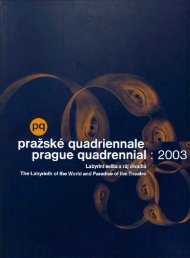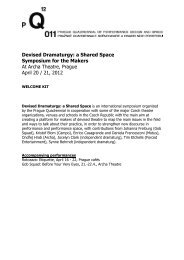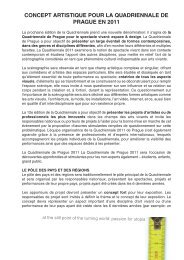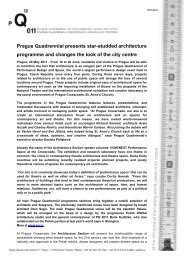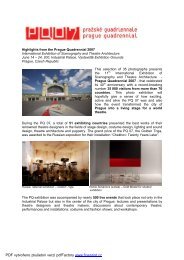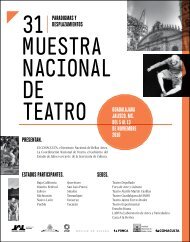Intersection: Intimacy and spectacle - Prague Quadrennial
Intersection: Intimacy and spectacle - Prague Quadrennial
Intersection: Intimacy and spectacle - Prague Quadrennial
You also want an ePaper? Increase the reach of your titles
YUMPU automatically turns print PDFs into web optimized ePapers that Google loves.
Ana Borralho <strong>and</strong> Joao Galante’s installation-performance. Photo: Vasco Célio.<br />
Mention should also be made here, amongst<br />
the forgotten greats of scenographic renovation,<br />
a certain Jacques Polieri, co-founder with Le<br />
Corbusier of the “Festivals de l’avant-garde”<br />
in 1956 in Marseilles, then in Nantes (1958)<br />
<strong>and</strong> Paris (1960). In France, Polieri encouraged<br />
recognition of abstraction in theatre,<br />
with a notable production of the Livre by Mallarmé<br />
in 1967, <strong>and</strong> an adaptation of Sonorité<br />
jaune by K<strong>and</strong>insky in 1976. “Polieri destroyed<br />
the classical stage-front by integrating the<br />
first video projectors <strong>and</strong> electronic cameras<br />
as early as 1964 for his ballet Gamme de 7.<br />
The space was enlarged by repositioning the<br />
audience in the context of a new representation.<br />
These attempts to deconstruct the interior of an<br />
Italian-style theatre would lead to stage sets<br />
that were mobile, multiple, annular or 360°. The<br />
construction of a mobile venue in 1968 in Grenoble<br />
for the Olympic Games is a perfect example of<br />
this trend. Its foundations revolutionized the<br />
classical context,” writes Franck Ancel (3).<br />
For the Universal Exhibition at Osaka in 1970,<br />
himself from the familiar l<strong>and</strong>marks that usually<br />
keep him afloat, <strong>and</strong> to encourage him to<br />
find his own buoyancy in the torrent of signs<br />
available to him, offered by every performance<br />
or form of <strong>spectacle</strong>. This then truly becomes<br />
a crossing, <strong>and</strong> there is general agreement<br />
that as such, the scenography becomes a<br />
question of time as well as space. As Michael<br />
Fried wrote back in 1967 in Art as Objecthood,<br />
“numerous practices (essentially within minimalist<br />
art) are constructed with less emphasis<br />
on the choice of medium than with a representation<br />
of this medium in order to be projected<br />
into another dimension of space <strong>and</strong> especially<br />
of time.” From the outset of the 20 th century,<br />
“Western avant-gardes, from constructivism to<br />
Fluxus via Dada, in order to define themselves,<br />
continually structured the stage by their means<br />
of expression thereby freeing themselves from<br />
contemporary practices.” (1)<br />
Abstraction <strong>and</strong> narrative outline<br />
Whereas Erwin Piscator (1893-1966), founder<br />
of the proletarian theatre, viewed theatre as<br />
“the academy for humanity’s gestures”, his<br />
contemporaries Adolphe Appia (1862-1928)<br />
<strong>and</strong> Edward Gordon Craig (1872-1966) were the<br />
first to view the space of the theatrical presentation<br />
as an autonomous, flexible, mobile<br />
entity. Their Utopia was partially interrupted<br />
by the Second World War <strong>and</strong> Nazism when,<br />
suppressing reality, it chose a mask <strong>and</strong><br />
barbaric weapons for that which will forever<br />
be the most abominable scenography of the<br />
elimination of undesirable beings (Auschwitz<br />
<strong>and</strong> the concentration camps). Even such<br />
genocidal madness, however, did not bring an<br />
end to questions on this subject, which is the<br />
very essence of modernity: Bernard Blistène<br />
refers in this way to “a desire for corporeity that<br />
the whole of modernity is dem<strong>and</strong>ing due to the<br />
resonance of both object <strong>and</strong> machine.” (1)<br />
Instigator <strong>and</strong> commissioner, with Yann<br />
Chateigné, of the historic exhibition Un théâtre<br />
sans théâtre at Barcelona’s Contemporary<br />
Art Museum (in 2007), Bernard Blistène was<br />
determined to celebrate the work there of<br />
Meyerhold <strong>and</strong> Oskar Schlemmer, Tadeusz<br />
Kantor <strong>and</strong> Dan Graham, Antonin Artaud,<br />
Allan Kaprow <strong>and</strong> the whole range of artistic<br />
performers, for the most part visual<br />
artists, but also featuring some shamefully<br />
overlooked pioneers such as Guy de Cointet<br />
(1934-1983), French artist who settled in Los<br />
Angeles in the early 1970s <strong>and</strong> who had a profound<br />
influence on Allen Ruppersberg, Mike<br />
Kelley et Paul McCarthy amongst others. In<br />
his work, half-way between theatre, dance<br />
<strong>and</strong> cinema, “the narrative outline becomes a<br />
playful pretext to explain the show’s accessories.<br />
These abstract elements, carrying letters or<br />
signs, become significant when maneuvered.<br />
(…) Via this process of the ‘humanization of<br />
the object’, the physical space totally defines<br />
the action.” (2)<br />
(1) – Bernard Blistène, Un théâtre sans<br />
théâtre, interview with Bertr<strong>and</strong> Raison, in<br />
Pavillon, scenography/theatrical review, n° 2,<br />
avril 2009.<br />
(2) – Marie de Brugerolle, Guy de Cointet,<br />
chaînon manquant dans l’histoire de l’art<br />
conceptuel californien, in Art Press n° 282,<br />
September 2002.<br />
(3) – Franck Ancel organized <strong>and</strong><br />
coordinated a retrospective on Jacques<br />
Polieri: creator of a modern scenography at<br />
the BnF in Paris (2002), <strong>and</strong> at the 'Institut<br />
culturel Français’ in Berlin (2003).<br />
(4) – Publications by Jacques<br />
Polieri: Scénographie nouvelle (publisher:<br />
Architecture d'aujourd'hui), Scénographie-<br />
Sémiographie <strong>and</strong> Jeu(x) de communication<br />
(publisher: Denoël), as well as Spectacles:<br />
50 ans de recherches, book-manifesto<br />
published in 1958 <strong>and</strong> re-edited by Biro<br />
en 2006.<br />
(5) – The “Département scénographie de<br />
l’Ecole nationale supérieure d’architecture”<br />
of Nantes <strong>and</strong> more specifically the<br />
department of GERSA, Groupe d’étude et<br />
de recherche scénologique en architecture,<br />
working since 2009 on the theme of<br />
immersive theatre. This research theme<br />
is also the subject of scenographic <strong>and</strong><br />
architectural projects on the “Scénographe<br />
DPEA” training program <strong>and</strong> part of the<br />
architectural cursus forming part of the<br />
“Architecture des lieux scéniques” project.<br />
This is offered in liaison with the “Scenographia”<br />
project <strong>and</strong> research on a virtual<br />
theatrical cage. This research is associated<br />
with a long-term exchange project known as<br />
F.A.U.S.T.T. (Fusion Architecture Scénographie<br />
Urbanisme Technologies Territoires), a<br />
project in association with the FAI AR<br />
Formation avancée itinérante aux arts de la<br />
rue (in Marseille), the Hochschule by Anhalt<br />
in Dessau <strong>and</strong> the Fondation du Bauhaus.



